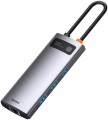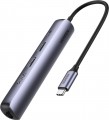USB А
The number of USB inputs located on the case of the card reader or hub (see "Type"). The number of USB ports that you will have at your disposal after connecting the device depends on this parameter. "Pure" card readers and combined models, usually, have 1,
2 and even
3 USB inputs, while hubs have
4 or more ports.
USB-C version
The USB connector interface (version) primarily characterizes the speed.
- 2.0. The outdated version 2.0 provides data transfer rates up to 480 Mbps. Found only in USB A ports.
— 3.2 gen1. Previous standard names are 3.1 gen1 and 3.0. This version provides up to 10 times the maximum speed (4.8Gbps) as well as higher power capacity, which allows you to connect power-hungry devices and large splitters.
- 3.2 gen2. Further improvement of the 3.2 gen1 standard (and, as is customary, the previous name more than once renamed 3.1 gen1 and simply 3.1), which made it possible to achieve a maximum speed of 10 Gbps and even higher power for external devices.
However, the final speed depends not so much on the input connector, but on the USB version of the hub (card reader) connection to the PC.
Power Delivery
The technology allows you to work at higher voltage, thereby increasing the transmitted power.
USB hubs with Power Dlivery can not only charge smartphones faster, but also power more power-hungry devices, such as laptops.
Cable length
The length of the cable supplied with the device. Mostly relevant for models with a non-removable cable that cannot be replaced.
Activity indicator
Light indicator, indicating that data is currently being exchanged between the memory card and the computer to which the card reader is connected. This allows you to avoid disconnecting the card reader during operation, which is fraught not only with data loss, but even damage to the device.

